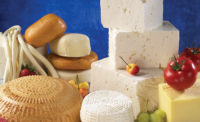
John A. Lucey is a professor of food science at the University of Wisconsin, Madison, and the director of the Center for Dairy Research.
The specialty cheese category is continuing to grow as consumers are looking for new and interesting cheeses with unique flavors and attributes. Here in Wisconsin, cheesemakers will soon be annually producing 1 billion pounds of specialty cheese.
So, what exactly is specialty cheese? While the definition has not been formalized, it is often taken for granted that specialty cheeses are not Cheddar, Mozzarella, or Swiss. Yet, another definition suggests that specialty cheeses has limited production and have unique characteristics and flavors. However, there is a lot of wriggle room. For example, cave aged or bandaged Cheddars, while once the mainstay of the industry, now are considered specialty products.
Use of Lactobacillus helveticus in the manufacturing of Cheddar has given cheese processors another unique category — “sweet Cheddar.” Perhaps a better definition relies on the fact that specialty cheeses have limited production and unique characteristics and flavors. Yet, let’s not get caught up in a formal definition as the cheese will speak for itself.
There is a whole range of cheeses that fall into the specialty cheese category — there are hard cheeses that age over several years and others that age for much shorter times, like mold-ripened cheeses. One thing in common is that many of these are cheeses that are traditionally aged in a cave, which, pre-refrigeration, provided an environment (humidity, bacteria, mold, etc.) where the cheese could age and ripen.
A cheese processing plant’s modern aging facilities essentially take this traditional cave-aging method and give it a new twist. Modern aging caves, or ripening rooms, allow for the environment to be closely monitored and programed so that the right conditions (e.g., humidity, temperature, air flow, etc.) foster specific kinds of artisanal cheese. In addition to aging facilities, newer equipment to produce specialty cheese is now available to aid with all steps of the manufacturing process.
So, let’s go over some of the key components and equipment used for producing specialty cheeses.
Aging Room Conditions: It is crucial to dial in the specific temperature and humidity as well as air flow to properly age cheese. For instance, if the air is too dry, the outside of a cheese will dry out as it ages. The rind can develop cracks, and this will also impact the growth of bacteria/mold flora on the cheese surface. This is why setting the humidity at the correct level for a particular cheese is crucial. Air flow can also dry out the cheese surface if air is blowing directly onto the cheese. A modern air handling system can help avoid these issues and provide high-quality, filtered air in sensitive area like cheese ripening rooms.
Wooden Aging Boards: While not a new technology, there are several interesting characteristics of wooden aging boards that contribute to the cheese aging process. Wood holds moisture and will therefore help maintain a consistent level of humidity in the aging room. In addition, wood also contains compounds that promote bacteria growth so that the boards will develop microflora, which can positively contribute to the aging process. Compared to wood, plastic aging shelves are rather inert as far promoting the growth of cultures. For some cheese varieties, therefore, it is basically impossible to have the same type of aging moving from wood boards to plastic boards.
White Mold Cheese: There are several interesting aspects to making white mold cheese. For instance, vats used to produce this cheese don’t have heated jackets on them because the milk isn’t heated in the vat. To produce high-moisture, soft specialty cheese like white mold cheeses, we add milk to the vat and, after clotting and stirring, we hoop the curd and then it will sit overnight. The pH of these cheeses is very low (around 4.6). It is important to control sanitation of the room where the cheese is held overnight. The room also must be warm enough for the cheese to ferment. Finally, like aging or ripening rooms, it’s crucial for the room to have proper air quality (i.e., filtered air, positive air pressure). One other note is that white mold cheese are not aged on wooden or plastic boards but use metal racks with spacing between wires to allow uniform exposure to oxygen.
Copper Vats: For traditional Swiss and Alpine-style cheeses, most cheesemakers prefer using copper vats. Copper vats involve some special attention and expertise because some copper does leach into the milk. Special attention needs to be paid to the type of cleaners/chemicals used on copper vats as well as carefully monitoring the pH of the cheesemilk in the vat. That said, it appears copper causes some oxidization reactions to occur in the milk and therefore modifies flavor of the cheese and positively impacts the final flavor profiles. One thing to be aware of is that, here in Wisconsin, there are specific state regulations regarding the use of copper/copper-lined vats.
Smear/Washed Rind: Smearing is an important feature of some washed-rind cheeses. Traditionally, an aged cheese is wiped with a salt solution and then that solution is used to wipe young cheese in hopes of transforming the desired formula of bacteria, yeast, and/or mold onto the new cheese. A salt solution works well as it seems to promote specific floras that are desired for cheese. Each day, the cheese is smeared or washed with the salt solution until it develops the amount of desired flavor.
Continuous Cheese Lines: There is a whole array of newer equipment designed specifically for producing specialty cheeses. Specifically, several companies have developed continuous cheese lines that are composed of a line of basins or containers. At the beginning of the line, the basin is filled with cheesemilk and then the filled basins move through a conveyor system where they undergo the different cheesemaking steps (e.g., coagulation, cutting, draining, etc.). These lines are highly flexible, with the goal to reduce the amount of losses and increase efficiency.
Other Equipment: Technology and equipment also have advanced for other steps in the specialty cheesemaking process, including the filling and handling of cheese molds. Equipment is available that can fill molds at high speeds. This technology can also lift, stack, and turn molds (to allow for proper draining). In addition, there is equipment to help with dry salting of cheese; evenly distributing salt on the surface of cheese. Still more equipment is available, like specially designed CIP systems to clean molds and specialty cheese equipment.
These are just some of the processes and newer equipment available to specialty cheesemakers. There is a lot of sophistication in this area. This newer equipment can help plants increase productivity and may also be more hygienic and decrease the risk of unwanted molds and bacteria from coming into contact with product. With these advances, we can look forward to continuing growth in the specialty cheese category.




